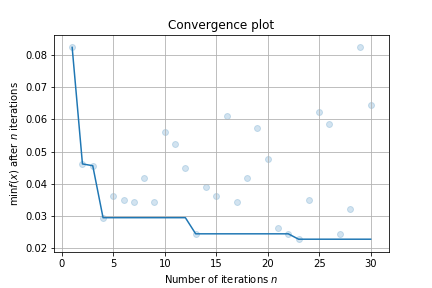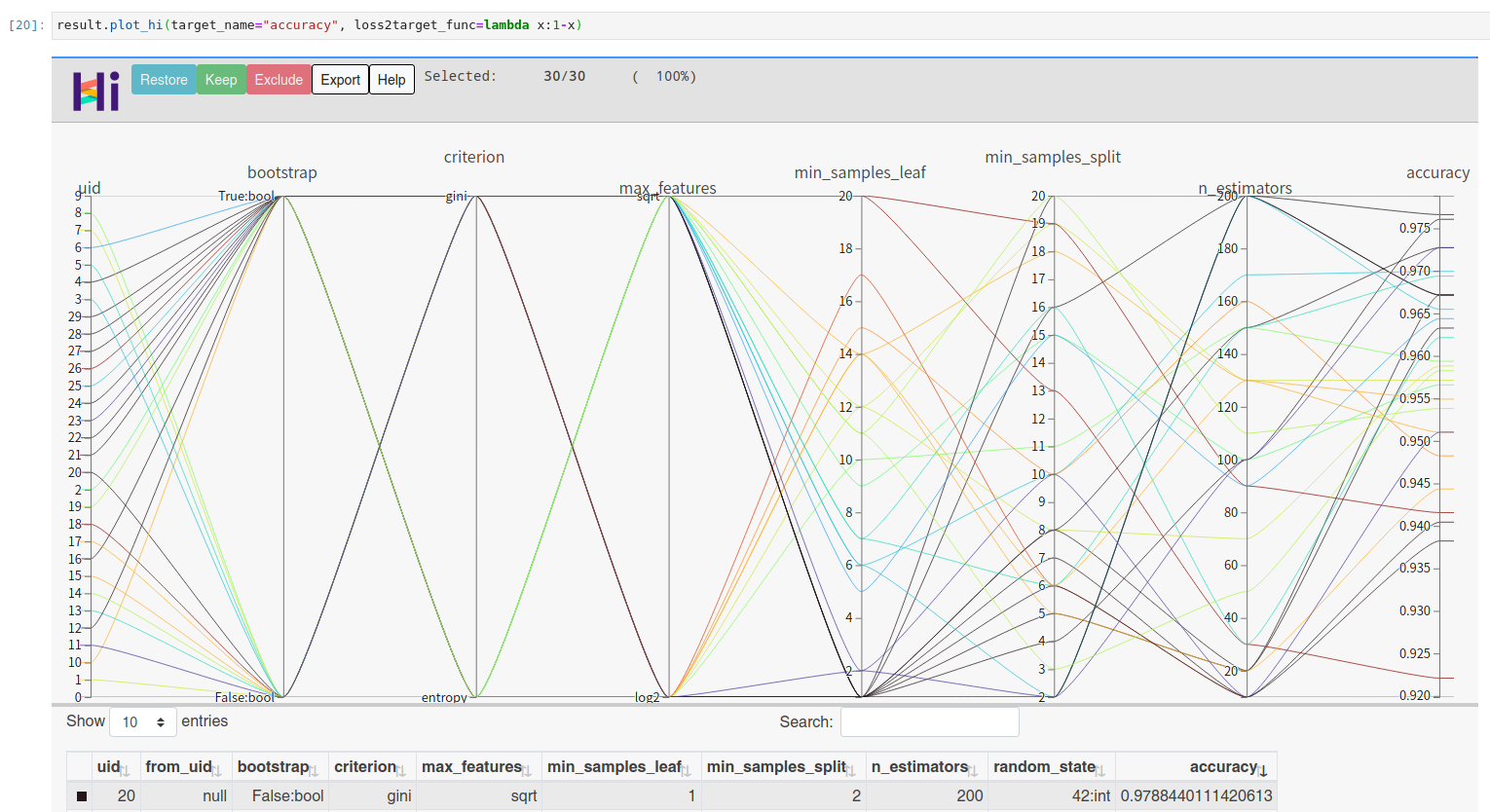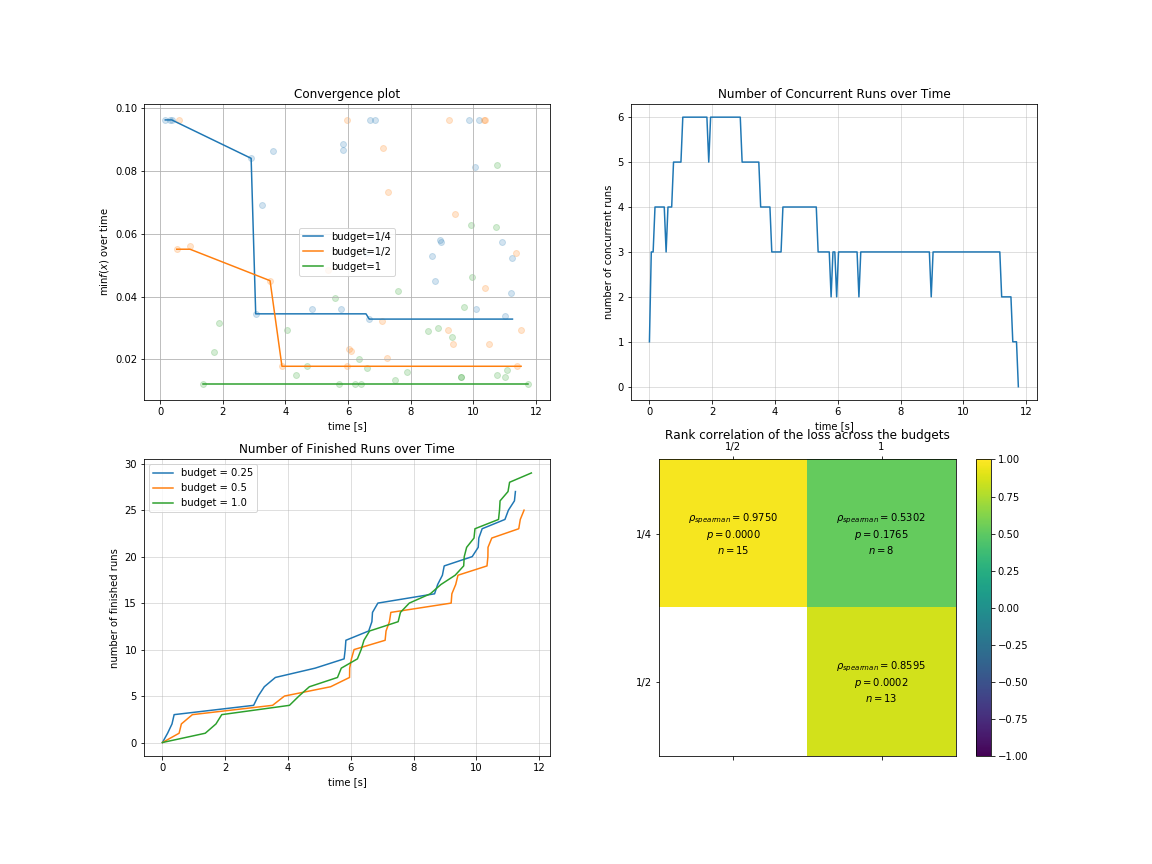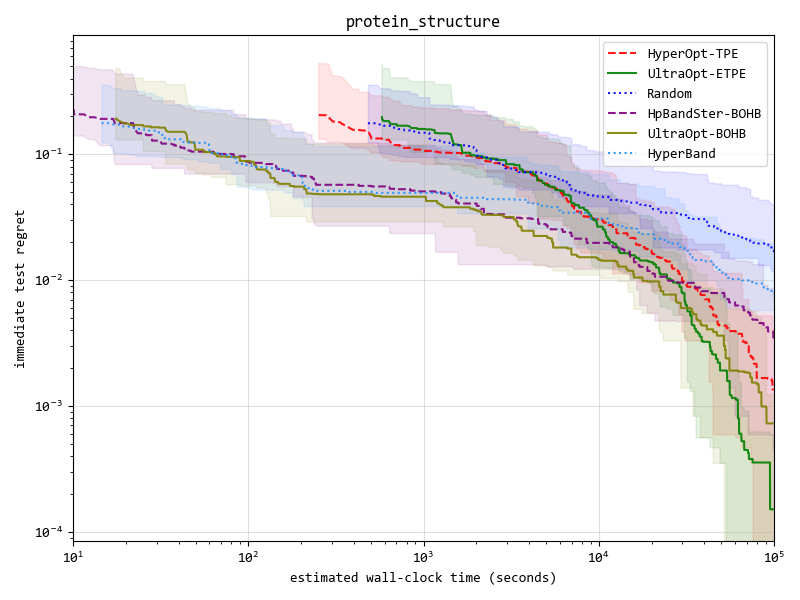
UltraOpt : 比HyperOpt更强的分布式异步超参优化库。
UltraOpt 是一个简单有效的优化库用于优化含噪音且评估代价大的黑盒函数,他能在大量的领域中应用,如超参优化(HyperParameter Optimization,HPO)和自动机器学习(Automatic Machine Learning,AutoML)。
在吸收了已有的优化库,如HyperOpt[5], SMAC3[3], scikit-optimize[4] and HpBandSter[2]的优点后,我们开发了 UltraOpt ,它实现了一个新的贝叶斯优化算法:ETPE(Embedding-Tree-Parzen-Estimator,嵌入树形Parzen估计器),在我们的实验中,这个算法比HyperOpt的TPE算法表现更好。除此之外,UltraOpt 的优化器被重新设计为能够适应HyperBand 和 SuccessiveHalving 评价策略[6][7]和MapReduce 和 异步通信 计算场景。最后,你可以通过UltraOpt的工具函数对配置空间和优化过程与结果进行可视化。
其他语言: English README
Documentation
English Documentation is not available now.
Tutorials
English Tutorials is not available now.
Table of Contents
Installation¶
UltraOpt 需要 Python 3.6 或更高.
You can install the latest release by pip:
pip install ultraopt
你可以下载仓库后手动安装:
git clone https://github.com/auto-flow/ultraopt.git && cd ultraopt
python setup.py install
Quick Start¶
Using UltraOpt in HPO¶
让我们通过几个例子学习UltraOpt(你可以在Jupyter Notebook中尝试)。
在开始一个黑盒优化任务前,你需要提供两个东西:
参数的取值范围,或称 配置空间(Config Space)
目标函数, 接受
config(config是 Config Space的一个采样), 返回loss
让我们定义一个随机森林的 Config Space 通过 UltraOpt的 HDL (Hyperparameter Description Language,超参描述语言):
HDL = {
"n_estimators": {"_type": "int_quniform","_value": [10, 200, 10], "_default": 100},
"criterion": {"_type": "choice","_value": ["gini", "entropy"],"_default": "gini"},
"max_features": {"_type": "choice","_value": ["sqrt","log2"],"_default": "sqrt"},
"min_samples_split": {"_type": "int_uniform", "_value": [2, 20],"_default": 2},
"min_samples_leaf": {"_type": "int_uniform", "_value": [1, 20],"_default": 1},
"bootstrap": {"_type": "choice","_value": [True, False],"_default": True},
"random_state": 42
}
然后再定义一个目标函数:
from sklearn.ensemble import RandomForestClassifier
from sklearn.datasets import load_digits
from sklearn.model_selection import cross_val_score, StratifiedKFold
from ultraopt.hdl import layering_config
X, y = load_digits(return_X_y=True)
cv = StratifiedKFold(5, True, 0)
def evaluate(config: dict) -> float:
model = RandomForestClassifier(**layering_config(config))
return 1 - float(cross_val_score(model, X, y, cv=cv).mean())
现在,让我们开启一个优化过程:
from ultraopt import fmin
result = fmin(eval_func=evaluate, config_space=HDL, optimizer="ETPE", n_iterations=30)
result
100%|██████████| 30/30 [00:36<00:00, 1.23s/trial, best loss: 0.023]
+-----------------------------------+
| HyperParameters | Optimal Value |
+-------------------+---------------+
| bootstrap | True:bool |
| criterion | gini |
| max_features | log2 |
| min_samples_leaf | 1 |
| min_samples_split | 2 |
| n_estimators | 200 |
+-------------------+---------------+
| Optimal Loss | 0.0228 |
+-------------------+---------------+
| Num Configs | 30 |
+-------------------+---------------+
最后,进行一个简单的可视化:
result.plot_convergence()

你可以通过 facebook 的 hiplot 查看高维交互图:
!pip install hiplot
result.plot_hi(target_name="accuracy", loss2target_func=lambda x:1-x)

Using UltraOpt in AutoML¶
让我们尝试一个更复杂的例子:通过BOHB算法[2](结合了HyperBand[6]评价策略和 UltraOpt的 ETPE 优化器)解决AutoML的 CASH 问题 [1] (Combination problem of Algorithm Selection and Hyperparameter optimization).
你可以在这里学习条件参数和复杂HDL的定义,在这里学习怎么实现一个简单的AutoML,在这里学习AutoML的实现。
首先,我们需要定义一个解决 CASH 问题 的 HDL :
HDL = {
'classifier(choice)':{
"RandomForestClassifier": {
"n_estimators": {"_type": "int_quniform","_value": [10, 200, 10], "_default": 100},
"criterion": {"_type": "choice","_value": ["gini", "entropy"],"_default": "gini"},
"max_features": {"_type": "choice","_value": ["sqrt","log2"],"_default": "sqrt"},
"min_samples_split": {"_type": "int_uniform", "_value": [2, 20],"_default": 2},
"min_samples_leaf": {"_type": "int_uniform", "_value": [1, 20],"_default": 1},
"bootstrap": {"_type": "choice","_value": [True, False],"_default": True},
"random_state": 42
},
"KNeighborsClassifier": {
"n_neighbors": {"_type": "int_loguniform", "_value": [1,100],"_default": 3},
"weights" : {"_type": "choice", "_value": ["uniform", "distance"],"_default": "uniform"},
"p": {"_type": "choice", "_value": [1, 2],"_default": 2},
},
}
}
然后,定义一个附加budget参数的目标函数,以适应HyperBand[6]评估策略:
from sklearn.neighbors import KNeighborsClassifier
import numpy as np
def evaluate(config: dict, budget: float) -> float:
layered_dict = layering_config(config)
AS_HP = layered_dict['classifier'].copy()
AS, HP = AS_HP.popitem()
ML_model = eval(AS)(**HP)
scores = []
for i, (train_ix, valid_ix) in enumerate(cv.split(X, y)):
rng = np.random.RandomState(i)
size = int(train_ix.size * budget)
train_ix = rng.choice(train_ix, size, replace=False)
X_train,y_train = X[train_ix, :],y[train_ix]
X_valid,y_valid = X[valid_ix, :],y[valid_ix]
ML_model.fit(X_train, y_train)
scores.append(ML_model.score(X_valid, y_valid))
score = np.mean(scores)
return 1 - score
你应该实例化一个multi_fidelity_iter_generator对象,用来使用HyperBand[6]评估策略:
from ultraopt.multi_fidelity import HyperBandIterGenerator
hb = HyperBandIterGenerator(min_budget=1/4, max_budget=1, eta=2)
hb.get_table()
| iter 0 | iter 1 | iter 2 | ||||
|---|---|---|---|---|---|---|
| stage 0 | stage 1 | stage 2 | stage 0 | stage 1 | stage 0 | |
| num_config | 4 | 2 | 1 | 2 | 1 | 3 |
| budget | 1/4 | 1/2 | 1 | 1/2 | 1 | 1 |
让我们将 HyperBand 评估策略和 UltraOpt的 ETPE 优化器结合在一起 , 然后开启一个优化过程:
result = fmin(eval_func=evaluate, config_space=HDL,
optimizer="ETPE", # using bayesian optimizer: ETPE
multi_fidelity_iter_generator=hb, # using HyperBand
n_jobs=3, # 3 threads
n_iterations=20)
result
100%|██████████| 88/88 [00:11<00:00, 7.48trial/s, max budget: 1.0, best loss: 0.012]
+--------------------------------------------------------------------------------------------------------------------------+
| HyperParameters | Optimal Value |
+-----------------------------------------------------+----------------------+----------------------+----------------------+
| classifier:__choice__ | KNeighborsClassifier | KNeighborsClassifier | KNeighborsClassifier |
| classifier:KNeighborsClassifier:n_neighbors | 4 | 1 | 3 |
| classifier:KNeighborsClassifier:p | 2:int | 2:int | 2:int |
| classifier:KNeighborsClassifier:weights | distance | uniform | uniform |
| classifier:RandomForestClassifier:bootstrap | - | - | - |
| classifier:RandomForestClassifier:criterion | - | - | - |
| classifier:RandomForestClassifier:max_features | - | - | - |
| classifier:RandomForestClassifier:min_samples_leaf | - | - | - |
| classifier:RandomForestClassifier:min_samples_split | - | - | - |
| classifier:RandomForestClassifier:n_estimators | - | - | - |
| classifier:RandomForestClassifier:random_state | - | - | - |
+-----------------------------------------------------+----------------------+----------------------+----------------------+
| Budgets | 1/4 | 1/2 | 1 (max) |
+-----------------------------------------------------+----------------------+----------------------+----------------------+
| Optimal Loss | 0.0328 | 0.0178 | 0.0122 |
+-----------------------------------------------------+----------------------+----------------------+----------------------+
| Num Configs | 28 | 28 | 32 |
+-----------------------------------------------------+----------------------+----------------------+----------------------+
你可以对 多保真度 场景下的优化过程与结果进行可视化:
import pylab as plt
plt.rcParams['figure.figsize'] = (16, 12)
plt.subplot(2, 2, 1)
result.plot_convergence_over_time();
plt.subplot(2, 2, 2)
result.plot_concurrent_over_time(num_points=200);
plt.subplot(2, 2, 3)
result.plot_finished_over_time();
plt.subplot(2, 2, 4)
result.plot_correlation_across_budgets();

Our Advantages¶
Advantage One: ETPE optimizer is more competitive¶
我们实现了4种优化器(在下表中列出), 并且 ETPE 优化器是我们原创的优化器, 在我们的试验中,它比其他基于TPE的优化器如 HyperOpt的TPE 和 HpBandSter的BOHB 要表现更好。
Our experimental code is public available in here, experimental documentation can be found in here .
| Optimizer | Description |
|---|---|
| ETPE | Embedding-Tree-Parzen-Estimator, is our original creation, converting high-cardinality categorical variables to low-dimension continuous variables based on TPE algorithm, and some other aspects have also been improved, is proved to be better than HyperOpt's TPE in our experiments. |
| Forest | Bayesian Optimization based on Random Forest. Surrogate model import scikit-optimize 's skopt.learning.forest model, and integrate Local Search methods in SMAC3 |
| GBRT | Bayesian Optimization based on Gradient Boosting Resgression Tree. Surrogate model import scikit-optimize 's skopt.learning.gbrt model. |
| Random | Random Search for baseline or dummy model. |
Key result figure in experiment (you can see details in experimental documentation ) :

Advantage Two: UltraOpt is more adaptable to distributed computing¶
You can see this section in the documentation:
Advantage Three: UltraOpt is more function comlete and user friendly¶
UltraOpt is more function comlete and user friendly than other optimize library:
| UltraOpt | HyperOpt | Scikit-Optimize | SMAC3 | HpBandSter | |
|---|---|---|---|---|---|
Simple Usage like fmin function |
✓ | ✓ | ✓ | ✓ | × |
Simple Config Space Definition |
✓ | ✓ | ✓ | × | × |
Support Conditional Config Space |
✓ | ✓ | × | ✓ | ✓ |
Support Serializable Config Space |
✓ | × | × | × | × |
Support Visualizing Config Space |
✓ | ✓ | × | × | × |
| Can Analyse Optimization Process & Result | ✓ | × | ✓ | × | ✓ |
| Distributed in Cluster | ✓ | ✓ | × | × | ✓ |
| Support HyperBand[6] & SuccessiveHalving[7] | ✓ | × | × | ✓ | ✓ |
Citation¶
@misc{Tang_UltraOpt,
author = {Qichun Tang},
title = {{UltraOpt : Distributed Asynchronous Hyperparameter Optimization better than HyperOpt}},
month = January,
year = 2021,
doi = {10.5281/zenodo.4430148},
version = {v0.1.0},
publisher = {Zenodo},
url = {https://doi.org/10.5281/zenodo.4430148}
}
Reference
[4] https://github.com/scikit-optimize/scikit-optimize





